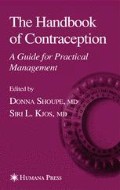Abstract
Concerns regarding the estrogen-related adverse effects with use of combination oral contraceptives (OCs) have led to a progressive reduction in the estrogen dose since their introduction in the 1960s. Prompting these concerns were the numerous epidemiological studies linking estrogen in OCs to breast cancer (1) and cardiovascular complications, including an increase in thromboembolic events and myocardial infarction (2). By the early 1990s, low-dose OCs containing 20–35 μg of ethinyl estradiol (EE) were the most commonly used formulations, and products with more than 50 μg of EE were no longer being marketed. Epidemiological studies reported improved safety profiles of these lower dose formulations (3–7) (Fig. 1).
Access this chapter
Tax calculation will be finalised at checkout
Purchases are for personal use only
Preview
Unable to display preview. Download preview PDF.
References
Collaborative Group on Hormonal Factors in Breast Cancer. (1996) Breast cancer and hormonal contraceptives: collaborative reanalysis of individual data on 53,297 women with breast cancer and 100,239 women without breast cancer from 54 epidemiologic studies. Lancet 347:1713–1727.
Anonymous. Oral contraceptives and cardiovascular risk. (2000) Drug Ther Bull 38:1–5.
Rosenberg L, Palmer JR, Rao RS, et al. (2001) Low-dose oral contraceptives use and the risk of myocardial infarction. Arch Intern Med 161:1065–1070.
Pettit DB, Sidney S, Bernstein A, et al. (1996) Stroke in users of low-dose oral contraceptives. N Engl J Med 335:8–15.
Siritho S, Thrift AG, McNeil JJ, et al. (2003) Risk of ischemic stroke among users of the oral contraceptive pill: the Melbourne Risk Factor Study (MERFS) Group. Stroke 34:1575–1580.
Kemmeren JM, Tanis BC, van den Bosch MA, et al. (2002) Risk of Aterial Thrombosis in Relation to Oral Contraceptives (RATIO) study: oral contraceptives and the risk of ischemic stroke. Stroke 33:1202–1208.
Lidegaard O, Kreiner S. (2002) Contraceptives and cerebral thrombosis: a five-year national case-control study. Contraception 65:197–205.
Rosenberg MJ, Meyers A, Roy V. (1999) Efficacy, cycle control, and side effects of low-and lower-dose oral contraceptives: a randomized trial of 20 μg and 35 μg estrogen preparations. Contraception 60:321–329.
Gallo M, Nanda K, Grimes D, Schutz K. (2005) Twenty micrograms vs >20 μg estrogen oral contraceptives for contraception: systematic review of randomized controlled trials. Contraception 71:162–169.
Mishell DR Jr. (2005) Rationale for decreasing the number of days of the hormone-free interval with use of low-dose oral contraceptive formulations. Contraception 71:304–305.
Collaborative Group on Hormonal Factors in Breast Cancer. (1996) Collaborative Group on Hormonal Factors in Breast Cancer and hormonal contraceptives: collaborative breast cancer reanalysis of individual data on 53,297 women and 100,239 women without breast cancer from 54 epidemiologic studies. Contraception 54:S100–S106.
Marchbanks PA, McDonald JA, Wilson HG, et al. (2002) Oral contraceptives and the risk of breast cancer. N Engl J Med 346:2025–2032.
Ory HW. (1983) Making choices: evaluating the health risks and benefits of birth control methods. Int Fam Plan Perspect 15:57–63.
Back DJ, Breckenridge AM, Crawford FE, et al. (1980) The effects of rifampicin on the pharmacokinetics of ethinyl estradiol in women. Contraception 21:135–143.
Murphy AA, Zacur HA, Charache P, Burkmand RT. (1991) Ehe effect of Tetracycline on levels of oral contraceptives. Am J Obstet Gynecol 164:28–33.
Marchbanks PA, McDonald JA, Wilson HG, et al. (2002) Oral contraceptives and the risk of breast cancer. N Engl J Med 346:2025–2032.
World Health Orgnization. Medical eligibility criteria. Available from: http://www.who.int/ reproductive-health/publications/mec/mec.pdf. Accessed: March 2006.
Grimes DA. (1993) Editorial: over the counter oral contraceptives-a immodest proposal? Am J Public Health 83:1092–1103.
Rosenberg MJ, Long SC. (1992) Oral contraceptives and cycle control: a critical review of the literature. Adv Contracep (Suppl) 1:35–40.
Zieman M, Nelson AL. (2002) Contraceptive efficacy and body weight. Female Patient 27:36–38.
Anderson FD, Hait H. (2003) The seasonale-301 Study Group. A multicenter, randomized study of an extended cycle oral contraceptive. Contraception 68:89–96.
Rosenberg MJ, Meyers A, Roy V. (1999) Efficacy, cycle control, and side effects of low-and lower-dose oral contraceptives: a randomized trial of 20 micrograms and 35 micrograms estrogen preparations. Contraception 60:321–329.
Graham CA, Ramos R, Bancroft J, Maglaya C, Farley TMM. (1995) The effects of steroidal contraceptives on the well-being and sexuality of women: A double-blind, placebo-controlled, two-centre study of combined and progestogen-only methods. Contraception 52:363–369.
Rosenberg M. (1998) Weight change with oral contraceptive use and during the menstrual cycle. Results of daily measurements. Contraception 58:345–349.
Lloyd T, Lin HM, Matthews AE, Bentley CM, Legro RS. (2002) Oral contraceptive use by teenage women does not affect body composition. Obstet Gynecol 100:235–239.
Rosenberg M. (1998) Weight change with oral contraceptives use and during the menstrual cycle. Results from daily measurement. Contraception 58:345–349.
Henney JE From the Food and Drug Administration. (2000) Risk of drug interactions with St. John’s wort. JAMA 283:1679.
Back DJ, Breckenridge AM, Crawford FE, et al. (1980) The effect of rifampin on the pharmacokinetics of ethinyl estradiol in women. Contraception 21:235–239.
Helms SE, Bredle DL, Zajic J, et al. (1997) Oral contraceptive failure rates and oral antibiotics. J Am Acad Dermatol 36:705–710.
Amsden GW, Mohamed MA, Menhinick AM. (2001) Effect of hormonal contraceptives on the pharmacokinetics of trovafloxacin in women. Clin Drug Invest 21:281–286.
Sanfilippo JS. (1991) Adolescents and oral contraceptives. Intl J Fertil 36:65–79.
Bailey P, Sanfilippo JS. (1993) Contraception in the adolescent. In: Shoupe DS, Haseltine FS, eds. Contraception. New York: Springer-Verlag, pp. 93–111.
Author information
Authors and Affiliations
Editor information
Editors and Affiliations
Rights and permissions
Copyright information
© 2006 Humana Press Inc., Totowa, NJ
About this chapter
Cite this chapter
Shoupe, D. (2006). Oral Contraceptives. In: Shoupe, D., Kjos, S.L. (eds) The Handbook of Contraception. Current Clinical Practice. Humana Press. https://doi.org/10.1007/978-1-59745-150-5_3
Download citation
DOI: https://doi.org/10.1007/978-1-59745-150-5_3
Publisher Name: Humana Press
Print ISBN: 978-1-58829-599-6
Online ISBN: 978-1-59745-150-5
eBook Packages: MedicineMedicine (R0)

